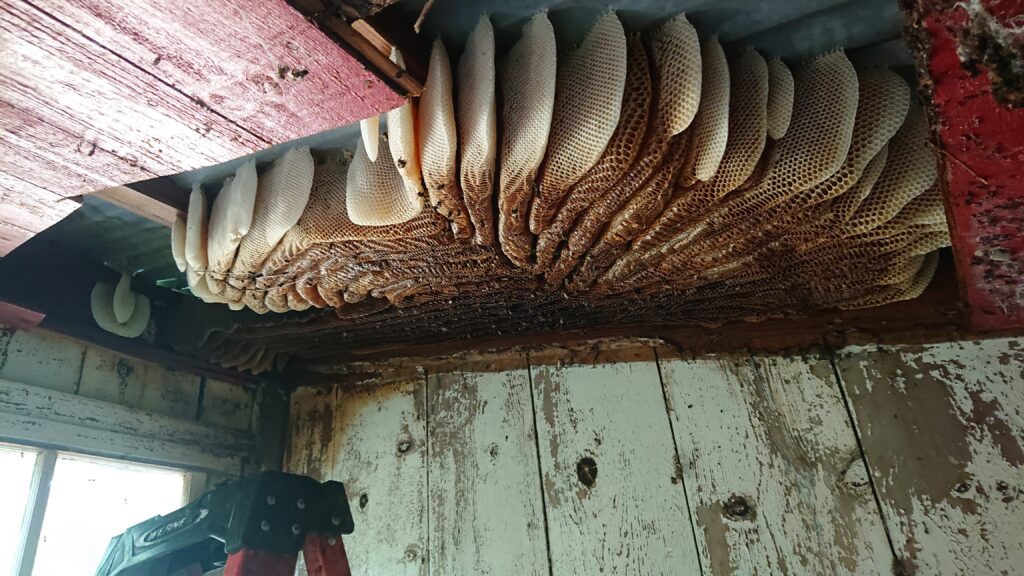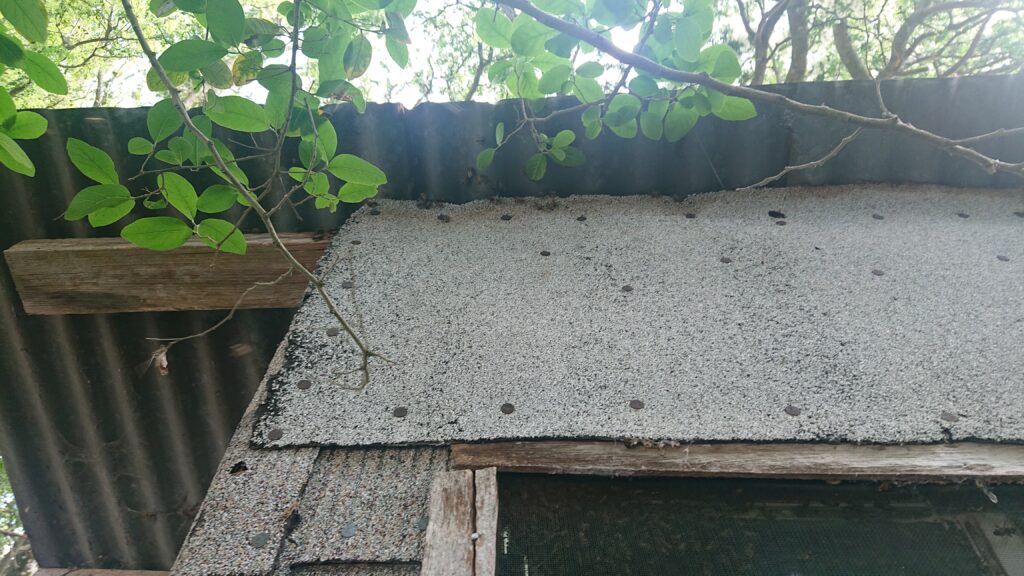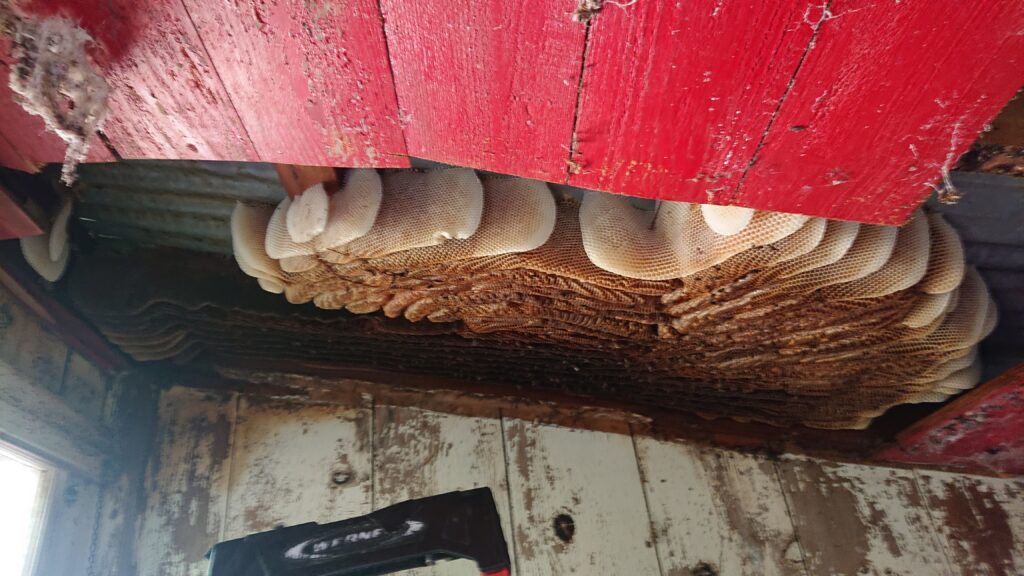Africanized Honeybees in the Rio Grande Valley
Africanized Honey Bees (AHB) are very similar to non-Africanized bees in many ways, however once a hive reaches a large size the differences become quite apparent. Visually it is nearly impossible to tell the difference between high content AHB, a bee with low AHB genetic content, and a pure bred of any other Apis Melferia sub-species. Without genetic testing it is nearly impossible to confirm the genetics, yet we can be certain that any feral beehive or beehive that has been allowed to requeen themselves will have some level of AHB genetics.

Today we encountered a hive that had been allowed to not only live, but thrive, on this homeowner’s property for several years. Being as industrious as any bee should, these bees had created a nest several feet long and contained 200+ pounds of honey. The first sting of the day occurred while we were just standing outside the hive; a bee went straight for the noggin and suits were immediately donned. We got our tools set up inside the shed and started vacuuming. Simply being inside the shed set these bees off on high alert and they started pouring out of their nest. Standing there we could see bees coming out of the ceiling right above us. Right next to us. A foot away from us. Okay over 2 feet away from us? Watching their activity made it so obvious that we were dealing with a monster of a hive! We could already tell roughly how large it was by the propolis and wax dripping from in-between the wood boards. If there was an “oh shit” moment, it was then.
But the bees weren’t satisfied with their performance. The longer we stood and vacuumed, the more ramped up they became. Pure bred European Honeybees only send out 10-20 guard bees on average, at least when we are discussing established hive boxes and equivalent sized feral nests. One of those differences between AHB and European bees is that guard reaction. An Africanized hive will quickly send hundreds, even over a thousand, bees to defend the hive. That’s the key, though, it is a DEFENSE. A European bee might only be mildly disturbed and then forget and forgive in a few hours, but an AHB colony has a memory that rivals the best of us. They’ll hold a grudge for several days, going after any perceived threat more vigorously than they would have before a disturbance.

Africanized bees that we know and love in the Rio Grande Valley are descended from an experimental cross bred of the hardy East African Lowland honey bee (A. m. Scutellata) and the calmer Italian honey bee (A. m. ligustica) and the Iberian honey bee (A. m. iberiensis). While both the Italian and Iberian subspecies have been worked by beekeepers for thousands of years, the East African bee has been hunted for thousand of years by tribes, honey badgers and other wildlife thus they have evolved to be highly defensive and quick to anger. East African bees had more predators that would completely destroy hives, and their disposition shows.
In the United States, AHB provide robust genetics that allow them to thrive through drought, pests, and have the ability to find a home where regular European honey bees might not. They are not the evil “killer bees” that the media has perpetuated, and in the honey capital of Mexico they are even preferred as they are far superior at honey production.
However, their highly defensive nature does make them dangerous. “Killer bee” is a bad moniker, yet they didn’t get the name for nothing. Once an AHB hive gets bigger, has more babies to protect, more food to protect, their defensiveness gets kicked into overdrive. Today was a textbook case in Africanized defensive procedures. If it wasn’t for the fact that this house had a decent amount of greenery and we were working inside of a shed, it would have been possible that people or animals in the area could have also been attacked.
Bee removals of Africanized honey bees work very similar to a bee removal in a place without any AHB genetics except a beekeeper needs to be aware of when a removal will be too dangerous. It is a sad fact that AHBs have been responsible for the death of some people and animals.

Today we had to make to make the unfortunate, but necessary, decision to kill these bees. They were too big and too mean to even relocate to our apiary, and that’s assuming they didn’t harm any of the neighbors during the removal themselves. We hadn’t even exposed the hive yet, and the bees were attacking so hard even the stings hurt more than normal. There are a few small behaviors that signify whether a hive is going to be too dangerous to let live: how many come out of the hive with minimal disturbance, how hard they try sting you, and one harder to notice behavior. This last action is watching HOW they try to sting. It’s easiest to see on the mask of a bee suit. Most of the time, bees trying to get at the face will fly up against and walk about a mask. When bees are biting the mask, unable to be physically removed from the mask without killing the bee, and they make this little “C” shape where they are grabbing the mask with their mandibles AND trying to push their stinger through the net, that is when you can gauge that this hive is probably too risky.
These bees exhibited all of these behaviors and it was not shocking given how large the hive was.
We are always thrilled when people say that they want the bees to be removed safely and that they feel bad about possibly hurting them, however allowing a feral hive of bees to remain on a property not only risks the homeowner but also endangers any neighbors, too. Had these bees been removed two or three years ago, maybe even a few months ago during winter, they would have probably made it out alive. Well established hives are always more defensive, whether they be Africanized or not, but here in the RGV we need to make sure that any feral colonies are relocated as soon as they are noticed.
Bees are great to have in a backyard but having feral bees on a structures is just not safe. If you want to have bees on your property you can always contact a local beekeeper, beekeeping association, or even the local agricultural extension as they should know of at least a few keepers in the area.
- Share:
One thought on “Africanized Honeybees in the Rio Grande Valley”
Comments are closed.







Outstanding information. This is something that everyone that lives in the RGV should understand. The issue with feral bees can be solved in an easy, humane, and cost-effective manner if the homeowner will call a beekeeper when a swarm is noticed or if they find a young colony.